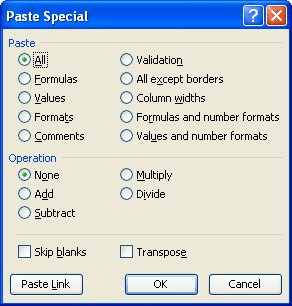Please Note: This article is written for users of the following Microsoft Excel versions: 97, 2000, 2002, and 2003. If you are using a later version (Excel 2007 or later), this tip may not work for you. For a version of this tip written specifically for later versions of Excel, click here: Quickly Updating Values.
Written by Allen Wyatt (last updated October 11, 2025)
This tip applies to Excel 97, 2000, 2002, and 2003
Many people use Excel to keep track of important information, such as price sheets or cost tables. This data is then used to help calculate proposals or to figure out how much should be charged to customers. It is not uncommon to need to update information in these tables on a periodic basis. For instance, your company may decide that it will increase all prices in the company by ten percent this year.
If you have rather large pricing tables, you may not know the best way to update the prices by the ten percent. Obviously you could make a secondary table and then base the information in that table on a formula, such as =B3 * 1.1. This is actually more work than is necessary, however. Excel provides a much quicker way to update values in a table by a uniform amount. Simply follow these steps:

Figure 1. The Paste Special dialog box.
That's it! All the values in your pricing table now show a ten percent increase from their previous values.
ExcelTips is your source for cost-effective Microsoft Excel training. This tip (2956) applies to Microsoft Excel 97, 2000, 2002, and 2003. You can find a version of this tip for the ribbon interface of Excel (Excel 2007 and later) here: Quickly Updating Values.

Dive Deep into Macros! Make Excel do things you thought were impossible, discover techniques you won't find anywhere else, and create powerful automated reports. Bill Jelen and Tracy Syrstad help you instantly visualize information to make it actionable. You’ll find step-by-step instructions, real-world case studies, and 50 workbooks packed with examples and solutions. Check out Microsoft Excel 2019 VBA and Macros today!
Enter information into a cell, and Excel needs to figure out what type of information it is. Here's how Excel interprets ...
Discover MoreGot some numbers and letters mixed up in the same cell? You may need to get rid of those letters so you are left with ...
Discover MoreExcel places limits on how much information you can enter into a cell and how much of that information it will display. ...
Discover MoreFREE SERVICE: Get tips like this every week in ExcelTips, a free productivity newsletter. Enter your address and click "Subscribe."
There are currently no comments for this tip. (Be the first to leave your comment—just use the simple form above!)
Got a version of Excel that uses the menu interface (Excel 97, Excel 2000, Excel 2002, or Excel 2003)? This site is for you! If you use a later version of Excel, visit our ExcelTips site focusing on the ribbon interface.
FREE SERVICE: Get tips like this every week in ExcelTips, a free productivity newsletter. Enter your address and click "Subscribe."
Copyright © 2025 Sharon Parq Associates, Inc.
Comments